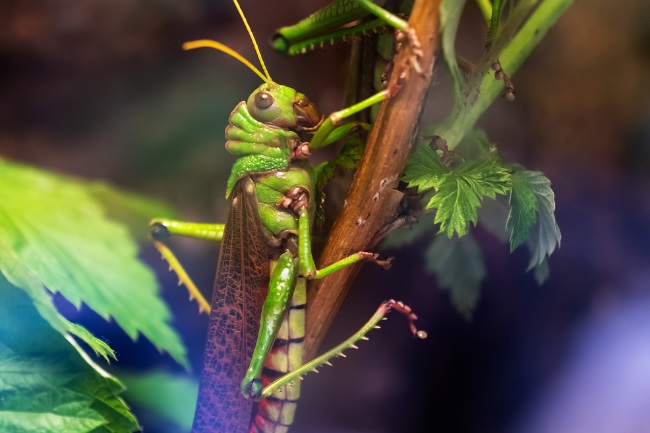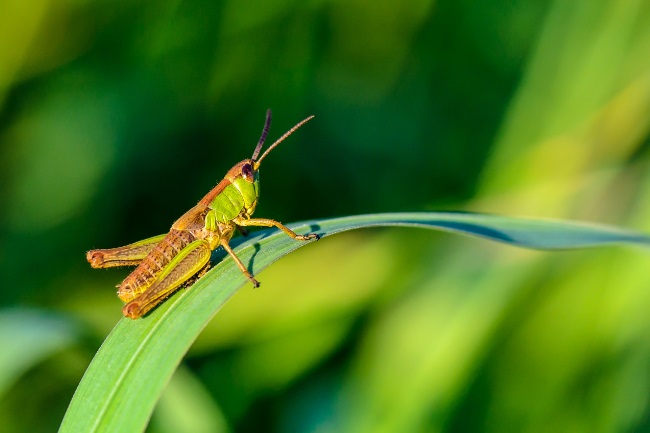Grasshoppers have three principal means of making sound; stridulation, crepitation and orally. Stridulation is using their back legs to rub across their wingcases to create a kind of buzzing. Crepulation involves pulling their wings taunt to create a crackling sound. Finally, grasshoppers can also generate a kind of chirrup with their mouths.
Contents
What is a grasshopper?
Grasshoppers are members of the Orthoptera order. While there are a number of different famillies of grasshopper within this order, including pygmy grasshoppers and matchstick grasshopper, the word grasshopper when commonly used is usually for those within the Acrididae subgroup. These are sometimes called short-horned grasshoppers; a descriptor once used to separate them from bush crickets, then called long-horned grasshoppers.

Grasshoppers are insects with long back legs designed to allow them to jump great distances. Most species also have wings and can fly to get away from predators, migrate, or even as part of their mating display. Like most insects, they have three main body parts; a head, a thorax and an abdomen. On their head they have a set of antennas, which they can use for picking up scents and other sensations such as heat.
Also read: Do Grasshoppers Make Noise? (Sound Production Explained)
Why do grasshoppers make noise?
Grasshoppers use noise mainly for two purposes; for defence and flirtation. The most famous sound a grasshopper can make is its evening serenade. This gentle buzzing sound can seem as though it’s emanating from the very ground on a hot day, with the musicians appearing nowhere to be found. Most grasshoppers practice cryptic colouration, mimicking the grass they spend most of their time in with stripes of green and brown across their body.
This camouflage means they can sing to their heart’s content and mostly go unnoticed. But why risk it at all when plenty of hungry mouths are waiting to gobble them up? For love, of course.

This sound is known as stridulation. It is made by the grasshopper rubbing small raised bumps on its back legs across their rigid wing casings. This acts as an echo chamber, vibrating and producing the sound we recognise as the grasshopper’s song. Experts can identify different species by their calls, as the size and spacings of the ridges create sounds of different pitches. Additionally, different types of grasshoppers will leave pauses at various points and for varying lengths.
| Sound Function | Description |
|---|---|
| Courtship Calls | Male grasshoppers use their sound-producing abilities to attract females for mating. They produce species-specific courtship calls that act as signals to female grasshoppers, indicating their presence and fitness for reproduction. |
| Territory Defense | Grasshoppers may produce sound to defend their territory from rival males or to establish their dominance. The sound serves as a warning to other grasshoppers to stay away from their chosen area. |
| Species Identification | Grasshopper sounds can be species-specific, acting as a way for individuals to identify and recognize members of their own species. These sound signals help grasshoppers locate potential mates and avoid mating with the wrong species. |
| Communication | Grasshoppers may use sound as a means of communication with other members of their species. This can include alarm signals to warn others of potential danger or aggregation calls to gather individuals in the same vicinity. |
Though both male and female grasshoppers can make these sounds, it tends to be the males we hear, as they need to impress and woo the females with their song. Female grasshoppers can glean information from the song such as the male’s health and size, important data when considering who to choose as a mate.
Even within species grasshoppers have more than one type of song. In fact, many species have five. Their main song will be the one they sing from their perches trying to call in a female. This will change if a rival appears, and some species will enter a kind of musical duel. The male will also start a different song if a female appears, and sometimes the female will start to sing back to them, though this is often much quieter than the male’s strumming. The final song comes just before courtship, with the male giving his finishing flourish before claiming his prize. Some species even have a particular song for when they are mating.
Noise for defence
As well as stridulation, some grasshoppers can make sound with their wings; this is known as crepitation. Although stridulation is only used for wooing, crepitation can be used for both romance and defence. The sound is created by the wings being snapped taut in mid-flight.
During display flights, grasshoppers will make this sound while interested females watch below. When used in defence, it is usually to surprise or scare a potential predator, as the grasshopper flies away trying to escape. Most grasshoppers can only stridulate but those that can crepitate can usually also stridulate.

As well as making music with their legs, grasshoppers can make a sound with their mouth. This is generally a gentle chirruping noise. This sound isn’t used very often by grasshoppers, as it’s not very impressive to the females and not very scary for their enemies.
| Sound Production Method | Description |
|---|---|
| Stridulation | Grasshoppers produce sound through stridulation, which involves rubbing body parts together. They have specialized structures on their wings or legs, known as stridulatory organs, that create the sound when rubbed against each other. |
| Wing Stridulation | Some grasshopper species produce sound by rubbing their wings together. The forewings, known as tegmina, have specialized veins or structures that produce a buzzing or chirping sound when rubbed against each other. |
| Leg Stridulation | Other grasshopper species produce sound by rubbing their hind legs against their wings or other body parts. The leg joints have specialized structures, such as ridges or file-like surfaces, that generate sound when rubbed together. |
| Vocalization | In addition to stridulation, some grasshoppers can produce sound through vocalization. They have specialized structures in their abdomen or thorax, known as sound-producing membranes or tymbals, which vibrate and create sound when air is forced through them. |
Some studies have found that if a grasshopper is held in a predator’s mouth when it chirrups, they are more likely to let it go, probably because the sound is amplified by the creature’s skull.
What grasshoppers are saying
While many species of animal have highly advanced and sophisticated languages, the grasshopper really only seems to speak of love and fear. Whether it be strumming along with their legs, or crackling their wings, they’re certainly one of the noisier insects. If you get to know your grasshopper songs, you can start to work out which species are singing to you. And as a female grasshopper listening in, you’ll be able to find out so much more.

